


|

|
Multiflora Rose
|
Quick Removal Tips
Identification |
|
|
Typical multiflora rose foliage. Each set of seven or so leaflets makes up one "complete," or compound, leaf.
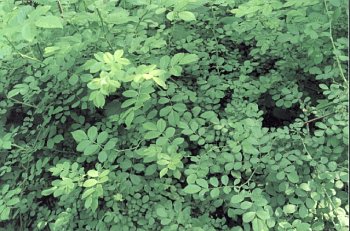
|
Rose flowers starting to fruit

|
|
An odd rose with pink petals, near the storm management pond bridge above Forest Glen. Occasionally a rose will lack thorns. Several exist below the Washington Adventist Hospital on the stream side of the Trail.

|
The leaves of rose are among the first to show in spring. Rose thorns are especially wide at the base, and point downward more than outward.

|
|
Sligo has no native rose now, but pasture rose was seen, rarely, by Sligo resident Salisbury in 1971. Pasture rose would not have this feathery appendage, or stipule, on the leaf stem.
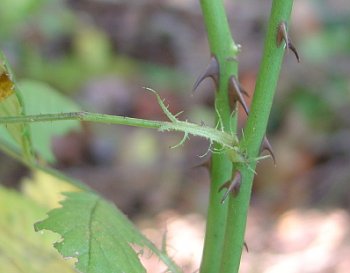
|
Like bush honeysuckle, rose canes (stems) arch sideways, from which leaders reach straight for light.

|
|
The leaders in summer
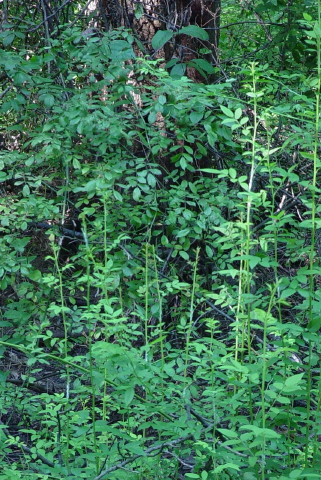
|
With time, old canes get woody and develop bark.
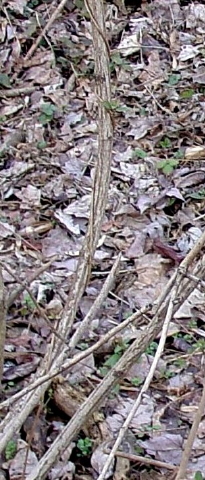
|
|
Rose berries are called hips, a word derived from an Indo-European word meaning thorn.

|
The photo on the right was taken on a foggy day. Hips from any rose species are reportedly good for tea.
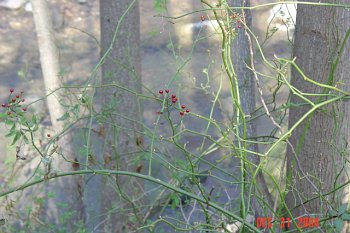
|
Look Alikes |
|
|
The native greenbrier might be mistaken by a novice for rose in winter. Greenbrier does not develop bark. Its thorns grow perpendicular to the stem, not downward.

|
Greenbrier leaves in summer. The brown spots are galls caused by a fly egg laid in early spring. This stimulated the plant to grow a blister gall around the egg. The larva feeds inside until fall then drops to the ground and pupates.
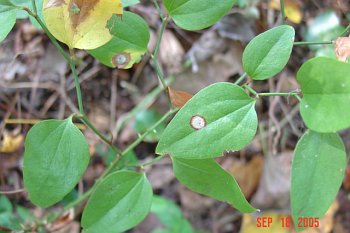
|
|
The light thorns are tipped with brown and are less wide than rose at the base.
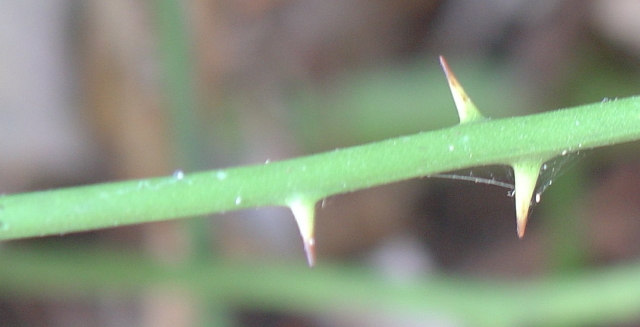
|
|
Technique |
|
|
In wet soil the roots of small and sometimes medium-size rose can be pulled. Mature rose with bark needs to be cut repeatedly every two or three months. Several features of rose show here: compound leaves, green stem and wide thorns curving downward.
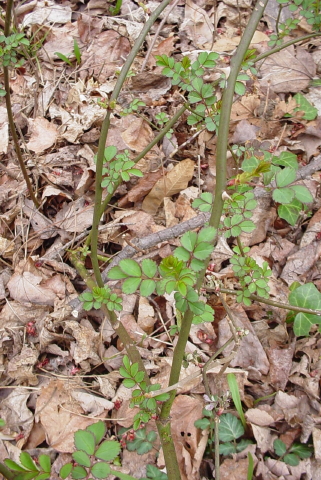
|
Deformed leaves and stem on multiflora rose in West Virginia, caused by rose rosette virus disease.

|
Rose Rosette Virus DiseaseA virus-like agent is spread by a mite and usually kills the rose within two years. The disease was discovered in the 1930s in California and Wyoming on wild rose, and since then has spread widely. It has not been seen in Sligo, although in February 2006 suspicious new leaves were seen in section 6 above Colesville Road.A website on cultivated roses, www.rose-roses.com/problems/otherdiseases.html discusses the effect of this disease on garden roses. The information seems to agree with statements by the Universities of Kansas and Nebraska, and comes down to "not to worry." Many budded or grafted roses are on Rosa multiflora root stock, but it is apparently the top growth that determines susceptibility, not the roots. The disease is not spread by pruners or any agent other than mites. Treatment: Many budded or grafted roses are on Rosa multiflora root stock, which needlessly worries some gardeners. Although Rosa multiflora is a host for the disease and for the eriophyid mite, a rose on multiflora roots is no more susceptible to rose rosette than it would be if it were on its own roots or on another type of rootstock. It is apparently the top growth and specifically the petiole-cane junction that determines susceptibility. This affliction is NOT spread by pruners or by any other known agent besides the tiny mites. So it is not contagious in that way. |
|